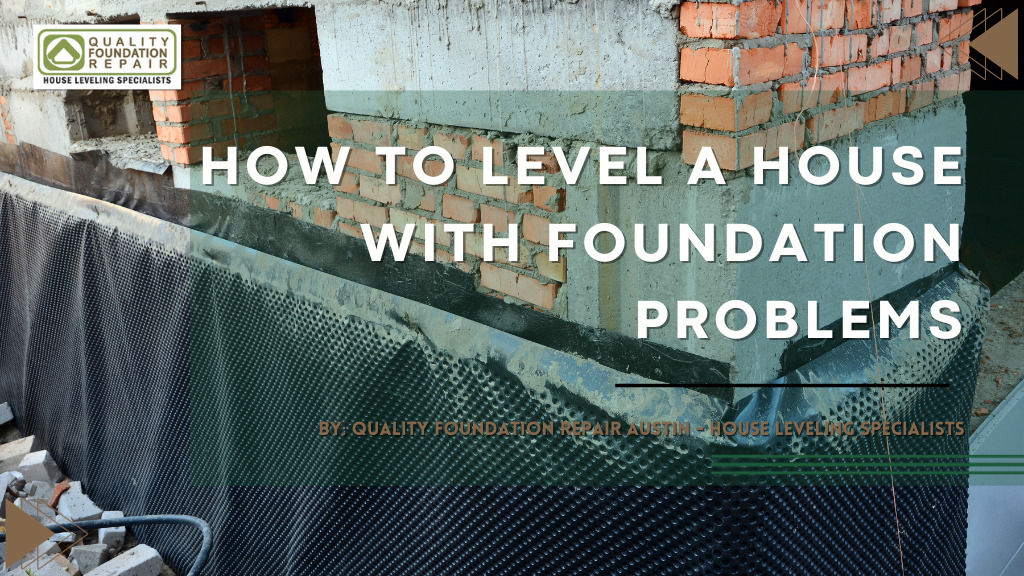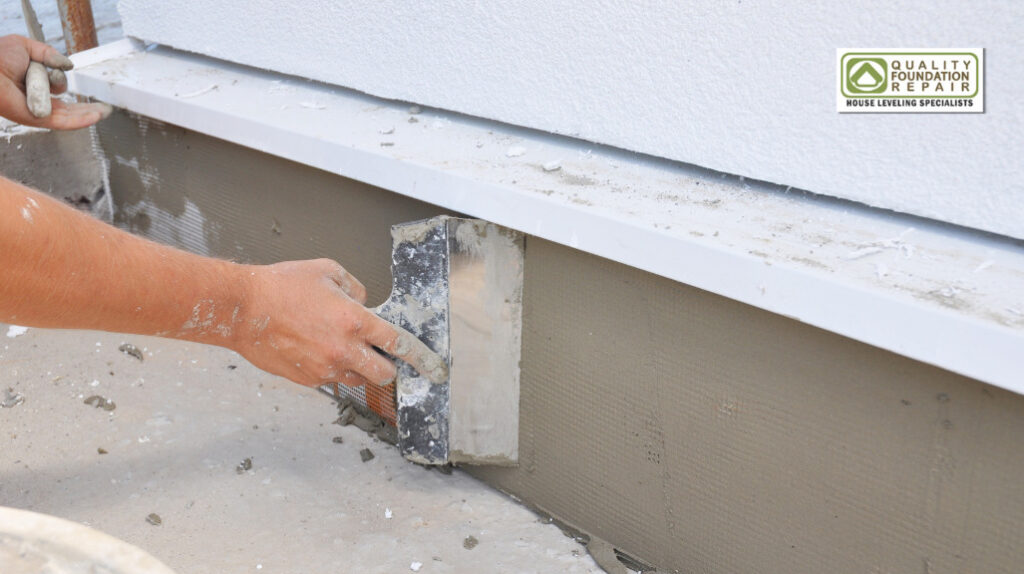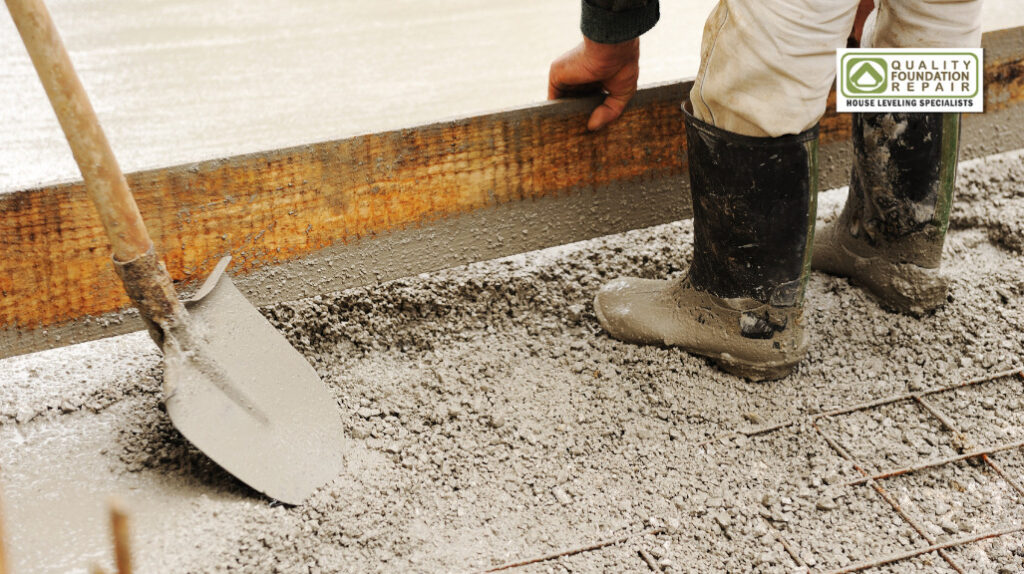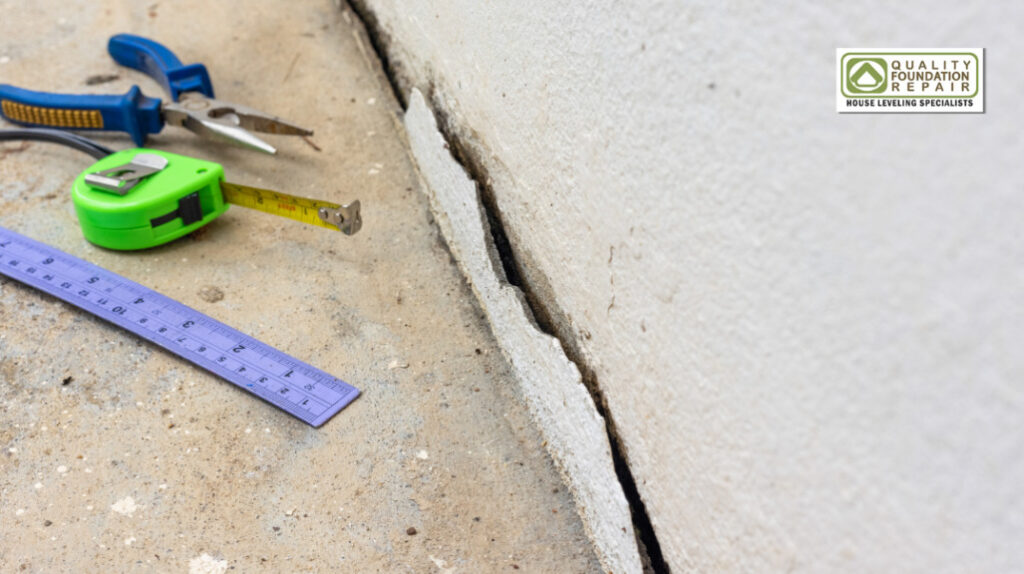
Many people wonder what house leveling is and if they need it. This short guide explains the basics and helps you understand how to level a house. Whether you have helical piers, concrete, or wooden blocks, you’ll focus on what to do and when to call a professional.
Every Foundation Settles
All foundations will settle into the soil, even if it’s a brand-new house. This is normal, and when it’s uniformly done (it happens to all house areas simultaneously), there’s absolutely nothing to worry about.
However, differential settlement is a considerable concern. This will happen when your house settles at different times. Overall, various sections settle at different rates. The foundation is stressed, and you’ll notice cracks in the walls, uneven flooring, and much more.

What’s House Leveling?
House leveling is a foundation repair procedure that will lift and level the settling house to where it had been before. Homes can experience differential settlement for various reasons, such as:
- Extra Moisture in the Soil – This is often caused by poor drainage around your foundation, but plumbing leaks can also be the problem.
- Expansive Soil – Expansive soils will swell whenever they take on moisture and shrink as they dry. The soil here isn’t stable and will move a lot, which can destabilize the foundation over time.
- Problems with Tree Roots – Tree roots require water and will search for it until they soak it under your foundation. This causes the soil to shrink and lead to foundation issues.
- Bad Construction – If the soil isn’t compacted correctly before the construction of the foundation, it will lead to differential settlement. You might notice sagging floors, windows that won’t latch, cracks in the chimney, walls, or ceilings, and other issues.
Every structure will settle at some point, and that’s normal. If it’s uniform, it will be fine, but you must deal with differential settlement as quickly as possible.
Two Types of Foundation Options
Regardless of your foundation type, house leveling can help you and usually follows a similar procedure. You’ll install more support under the building’s foundation, returning it to the original elevation and fortifying your supporting structures with concrete or steel.
Here are the two most common foundation types:
Concrete Slab Foundations
Concrete slabs are used for this foundation type and poured on the prepared base. They’re often bought as pre-manufactured blocks or constructed with a mixture of concrete over specific areas to solidify.
Typically, concrete slabs are a cheaper option for a foundation. Plus, they provide a solid surface that will hold up a heavy building. However, concrete is prone to moisture and water damage, leading to cracking and other problems. That’s why modern houses feature a moisture barrier beneath the concrete.

Method for Leveling Slab Foundations
The slab foundation repair process for concrete slabs includes foam jacking, slab jacking, and more. Several holes must be drilled into the concrete, and a professional injects a high-density polymer, which will expand.
Your slab will slowly rise as the polymer expands, which plugs the holes and compacts the soil. Regardless of the professional’s foundation repair method, you’ll want to get it done as soon as possible!
Pier and Beam Foundation
Pier and beam foundations get constructed with pillars or piers of treated concrete or wood beams. They are fastened to the top and across, with the floor joists laid across them. This foundation type offers a crawl space between the soil and the foundation.
Many homeowners like the idea of a crawl space because it helps them get inside to deal with wiring and other issues.
These foundations have been used for many years and are beneficial compared to concrete slabs. The crawl space will elevate the building, which prevents water from getting in. However, they’re more expensive, especially if you choose steel push piers or helical piers.
Method for Leveling a Pier and Beam Foundation
When dealing with pier and beam foundations, house leveling might also be beneficial. However, other remedial actions will be done, as well.
If the support beams have experienced rot in the wooden blocks, steel push piers will strengthen them. Typically, you’ll have to replace the wood, which can get pricey based on how many piers you have.
Generally, your piers are fortified using concrete pilings, and a professional requires special equipment to stabilize the joists. Girders under the structure will be leveled at the stations supporting the foundation or the existing piles with hydraulic jacks.
Do You Require Foundation Repair or House Leveling?
Whether you require house leveling or foundation repairs depends on the structural problems you’re experiencing. Knowing this without calling a professional for an inspection is often challenging.
Overall, leveling a foundation is dangerous, so it’s wise to call a skilled contractor. You may also require a structural engineer to assess the foundation and identify cracked or distressed areas. The contractor often requests a slab survey to see what’s happening underneath the home.

Choosing Foundation Repair Contractors
By now, you’ve probably realized that house leveling isn’t a DIY project. It’s unsafe to try doing it yourself! You’ll need foundation professionals to help you understand the issues, determine the right action, and do the work.
All foundations will settle, and that’s normal. Uniform settling should be expected and is likely nothing to worry about. However, differential settlement can lead to severe structural damage and foundation problems if you don’t fix them quickly.
If you’ve noticed saggy floors, cracks in the ceilings or walls, and other problems, a foundation repair might be in order. The first step is to contact the experienced professionals at Quality Foundation Repair Austin. Dial (512) 363-7769 to have someone out for an inspection to determine what’s wrong and what can be done to fix it.
FAQs about House Leveling
Is It Worth Leveling a House?
House leveling is crucial when you’re dealing with foundation problems. They won’t go away until the home is leveled. It could solve various issues, such as drywall cracks, foundation cracks, and sticking doors/windows.
How Much Does It Cost to Make a House Level?
Generally, the cost of house leveling depends on various things, such as the house’s overall condition, its size, what caused the settlement issue, the severity of the problem, what will be done to fix everything, your geographical location, and what method is used.
The only way to truly know the cost of leveling your house is to call a foundation repair company and request an inspection and estimate. Those professionals will address common concerns and devise a solution, providing you with information about the price.
How Do You Level and Jack Up a House?
House leveling is something you cannot do yourself. It requires using hydraulic jacks and many other specialty tools and equipment you can’t obtain.
Typically, holes are put in the foundation to lift the beams. Steel beams are put into the holes, and a large jack will pull them up. A professional will then add more soil and set the home back down.
How Do I Make Sure My Foundation Is Level?
In most cases, you’ll notice that house leveling is required. Here are a few tips to help:
1. Check the Grade – The soil around your home’s perimeter must slope away from the house to divert water from the foundation. If you have a flat grade and notice ponding or flooding near the house, it’s wise to update the drainage.
2. Examine Your Walls – A telltale sign of a foundation problem is to see cracks in the walls. Look for shifting or settling, which can appear as long vertical cracks.
3. Use a Laser Level – Your house might have settled unevenly, and you can use a laser level in the crawl space or basement to determine how unlevel it might be.



